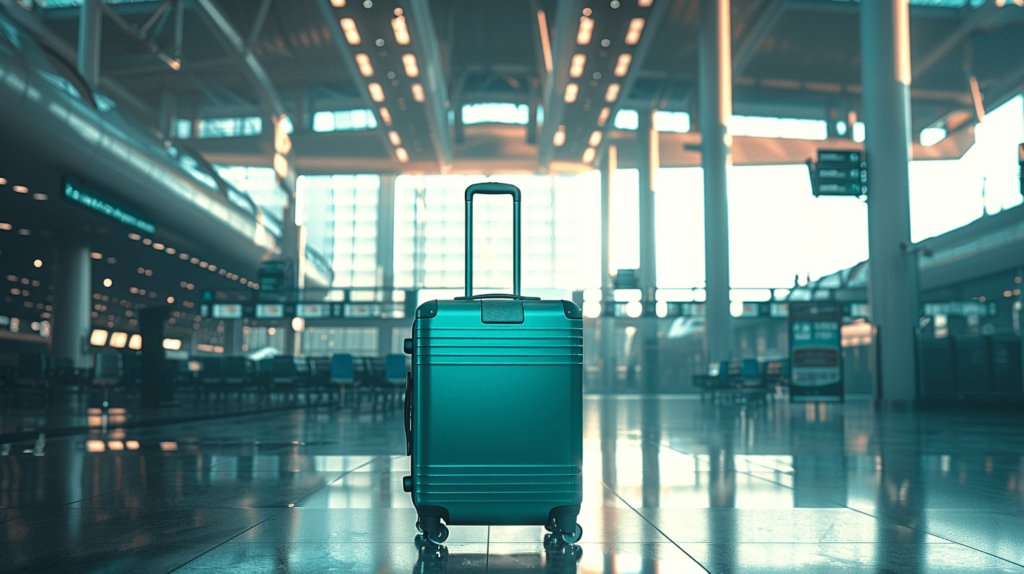Packing for a trip can often feel like solving a puzzle, especially when trying to fit everything into a carry-on bag. While it’s tempting to pack for every possible scenario, space is limited, and you should leave certain items at home. Knowing what not to bring in a carry on can save time, space, and potential hassle at airport security. This post will guide you through 15 items that you should consider leaving out of your carry-on luggage.

This site contains affiliate links, please view the disclosure for more information.
WHAT NOT TO BRING IN A CARRY ON
1. Large Liquid Containers
Even the most seasoned travelers can forget the restrictions on liquids in carry-ons. Any liquid, gel, or aerosol must adhere to the 3-1-1 rule: containers must be 3.4 ounces (100 milliliters) or smaller, all fitting within a single quart-sized, clear, zip-top bag. Larger bottles of shampoo, sunscreen, or other toiletries are a no-go. If you need larger amounts, it’s best to check a bag or buy what you need once you reach your destination.
2. Full-Size Beauty Tools
While it might be tempting to bring along full-size hair dryers, straighteners, or curling irons, these items take up valuable space and can often be found at your hotel or rental. If you must bring a beauty tool, opt for travel-sized versions that are more compact and just as effective.
3. Sharp Objects
Sharp objects such as scissors, pocket knives, or full-size razors can be confiscated at security checkpoints. To avoid losing your items, pack any necessary sharp objects in checked luggage or choose alternatives like disposable razors or nail clippers without a blade.
4. Weapons
This might seem obvious, but airlines and the TSA do not permit weapons of any kind, including firearms, pepper sprays, or blunt weapons, in carry-ons. You must declare and check these items according to airline and TSA regulations, which provide specific packing instructions.
5. Fresh Produce and Certain Foods
While snacks are essential for a comfortable flight, avoid packing fresh fruits and vegetables in your carry-on when traveling internationally. Many countries have strict customs regulations to prevent the introduction of pests and diseases. Pack pre-packaged snacks instead to avoid having your healthy treats thrown away.
6. Sports Equipment
Air travel regulations do not allow sports equipment like baseball bats, cricket bats, hockey sticks, and golf clubs in carry-on luggage due to their potential use as weapons. If traveling with sports equipment, you’ll need to check these items or rent them at your destination.
7. Flammable Items
Air travel regulations forbid all flammable items, including aerosols, fuels, or fireworks, in both carry-on and checked bags. This includes seemingly harmless items like novelty lighters or large quantities of matches. Stick to one book of safety matches if necessary.
8. Alcoholic Beverages Over 140 Proof
While you can bring alcohol in your carry-on, there are restrictions on the proof level. Any alcoholic beverage over 140 proof is prohibited as it is considered a fire hazard. Pack lighter beverages or buy your favorites once you land.
9. Gel-Type Candles and Gel Shoe Inserts
Gel candles and non-solid shoe inserts are not allowed in your carry-on. These gel items can obscure images on security x-rays, leading to potential security concerns.
10. Lithium Batteries
You can only carry spare lithium batteries, used in many electronic devices, in your carry-on and not in checked luggage due to fire risk. However, you must use these for personal purposes and should keep them in their original packaging or ensure that their terminals are protected from short circuits.
11. Heavy Jewelry or Metal Items
Heavy jewelry or bulky metal items can trigger security alerts and require additional screening. To ease your way through security, pack these items in your checked luggage or wear minimal jewelry to the airport.
12. Oversized Electronics
Laptops and tablets are fine, but larger electronic devices like desktop CPUs, monitors, or large speakers can complicate the screening process and better suit checked luggage.
13. Chemicals and Toxic Substances
Air travel guidelines strictly regulate any kind of chemical or toxic substances, including chlorine, bleach, and spray paint, and do not allow them in carry-ons. These materials are considered hazardous.
14. Cash or Valuable Documents in Large Amounts
While it’s smart to carry some cash, carrying large amounts or valuable documents in your carry-on can pose a risk in case of theft. Use safety features like money belts or neck pouches for better security, or leave high-value items in a safe at your destination.
15. Books in Excess
While a good book is a travel essential for many, packing too many can add unnecessary weight and take up space. Consider bringing an e-reader or utilizing airport book exchanges to keep your load light.
Understanding what not to bring in a carry on can make your travel experience smoother and more enjoyable. By packing smartly, you ensure a quicker passage through security and a more comfortable journey. Plus, you will avoid the risk of authorities confiscating your possessions, which can start your trip off on the wrong foot.
Streamlining Your Packing Process: What To Bring and Not Bring In Your Carry On
To further streamline your packing, here are a few additional tips to consider when deciding what not to bring in a carry on:
Utilize Packing Cubes
Packing cubes can help organize your belongings and compress them to fit more into your carry-on. They also make unpacking and re-packing easier when going through security or moving between destinations.
Choose Multi-Functional Clothing
Select clothes you can layer and mix to maximize your outfit options without overpacking. Items that can transition from day to night or from casual to semi-formal are particularly valuable.
Embrace Digital Tools
Instead of packing physical books, travel guides, or maps, use digital versions on your smartphone or tablet. Apps can often serve multiple functions, like currency converters, language translators, and travel guides, reducing the need for additional items.
Prepare for Toiletries
If you’re worried about liquid restrictions, consider solid alternatives like bar shampoos, conditioners, and toothpaste tablets. These items are travel-friendly, meet TSA guidelines, and save space.
Reassess Your Footwear
Footwear can be bulky and heavy. Limit yourself to wearing one pair of versatile shoes on the plane, and pack only one other pair if necessary. Choose shoes that are comfortable for walking and suitable for most occasions.
By focusing on what not to bring in a carry on and how to pack efficiently, you can enjoy a less stressful and more organized travel experience. Remember, the goal is to bring everything you need without overpacking. This approach not only eases your physical burden but also simplifies your mental load, allowing you to focus more on enjoying your trip and less on managing your luggage.
Final Thoughts on What Not to Bring in a Carry On
Traveling light with just a carry-on is an art form that requires thoughtful consideration of each item you decide to bring. By understanding the guidelines and planning carefully, you can avoid common packing mistakes and enjoy a smoother trip. Keep the list of what not to bring in a carry on handy, and you’ll be well on your way to becoming a more savvy and efficient traveler.
Safe travels, and remember, sometimes less really is more when it comes to packing for your next trip!



